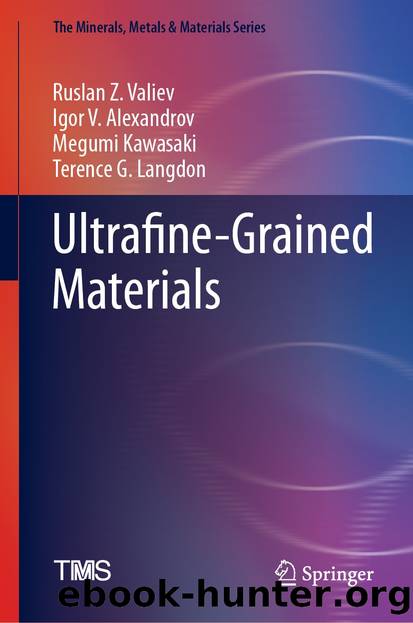Ultrafine-Grained Materials by Ruslan Z. Valiev & Igor V. Alexandrov & Megumi Kawasaki & Terence G. Langdon

Author:Ruslan Z. Valiev & Igor V. Alexandrov & Megumi Kawasaki & Terence G. Langdon
Language: eng
Format: epub
ISBN: 9783031317293
Publisher: Springer International Publishing
Fig. 3.13Surface of CG and NS samples of Grade 4 Ti after mechanical polishing and etching in the mixture of acids 30% HNOck.yt + 3% HF + H2O for 20 min: (a) CG Ti surface; (b) nano-Ti surface. SEM image. (Reprinted from [31], Copyright 2018, with permission from Elsevier)
The emission of Ti ions into the human body from UFG Ti implants is extremely low and much less than the histological level (level of presence of dangerous cells and neoplasms) established for Ti and equal to 5 ppm. By contrast, concentrations of Ti ions in the tissues surrounding CG Ti implants with grain size â¤1000 μm are usually much higher than in blood or saliva.
The deposition of biocompatible coatings on the surface of Ti implants and Ti-based alloys considerably increases the integration of implants and bone tissue [33â35]. At the same time, the actual problem is the synthesis of biocompatible coatings made from inorganic (Ca and P containing) and organic (containing bioactive and bioinert molecules) components on the implants. Biocompatible coatings contain hydroxyapatite (HA), which is the main crystalline component of human bone and a drug stimulant for osteosynthesis, but they obtain low adhesion to the Ti substrate as well as low mechanical strength. Plasma electrolytic oxidation (PEO) has recently been widely used for deposition of coatings containing Ca and P [33]. Application of this technique accompanied by high voltages contributes to microdischarges in the coating (Fig. 3.14a), its recrystallization, and intensive growth. The stable titanium dioxide modifications (rutile and anatase) are contained in the coatings. The deposition method featured by electrochemical oxidation and numerous melting and hardening of the microdischarged areas provides strong coupling to the surface. This method makes it possible to obtain the coatings with adjustable porosity and pore size from 0.1 to 10 μm (Fig. 3.14b) [34].
Fig. 3.14Images of microdischarges on the sample surface during the PEO process (a); SEM image of PEO Ca- and P-containing coating on titanium, top view (above) and cross-section (below) (b). (Reprinted from [31], Copyright 2018, with permission from Elsevier)
Download
This site does not store any files on its server. We only index and link to content provided by other sites. Please contact the content providers to delete copyright contents if any and email us, we'll remove relevant links or contents immediately.
Whiskies Galore by Ian Buxton(41720)
Introduction to Aircraft Design (Cambridge Aerospace Series) by John P. Fielding(33017)
Small Unmanned Fixed-wing Aircraft Design by Andrew J. Keane Andras Sobester James P. Scanlan & András Sóbester & James P. Scanlan(32685)
Aircraft Design of WWII: A Sketchbook by Lockheed Aircraft Corporation(32164)
Craft Beer for the Homebrewer by Michael Agnew(18082)
Turbulence by E. J. Noyes(7895)
The Complete Stick Figure Physics Tutorials by Allen Sarah(7265)
The Institute by Stephen King(6860)
Kaplan MCAT General Chemistry Review by Kaplan(6823)
The Thirst by Nesbo Jo(6759)
Bad Blood by John Carreyrou(6477)
Modelling of Convective Heat and Mass Transfer in Rotating Flows by Igor V. Shevchuk(6354)
Learning SQL by Alan Beaulieu(6159)
Weapons of Math Destruction by Cathy O'Neil(6085)
Man-made Catastrophes and Risk Information Concealment by Dmitry Chernov & Didier Sornette(5878)
Permanent Record by Edward Snowden(5682)
Digital Minimalism by Cal Newport;(5588)
Life 3.0: Being Human in the Age of Artificial Intelligence by Tegmark Max(5405)
iGen by Jean M. Twenge(5326)
